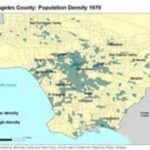In recent years, the issue of urban sprawl has become a prominent concern for both community and political leaders. Researchers examining this issue have noted that urban sprawl has a detrimental impact on the regions that it impacts. Specifically, it has been reported that, the problems that had once plagued inner cities-crime, pollution and increased traffic-are now having a larger impact on urban and suburban areas (Wasserman, 8). The problem of urban sprawl has lead to the development of new political initiatives which attempt to reduce urban sprawl and improve planning and infrastructure for affected areas. Such is the case with Smart Growth America.
Smart Growth America is “a nationwide coalition of over 60 public interest groups” which is seeking to reduce the impact of urban sprawl on America’s cities (Geller, 1410). The coalition focuses on four key aspects of urban sprawl including: low-density population development, rigidly separated homes, road networks with poor access and the lack of well defined urban centers (1410). Groups involved in the smart growth initiative believe that by reducing urban sprawl many of the problems associated with this process can be alleviated as well. Even though the smart growth initiative has been met with strong support from both public and private interests, the overall impact of the initiative has left some individuals and groups to argue that urban sprawl should not be stopped (1410).
With the realization that there are such dichotomous views on the smart growth initiative, there is a clear impetus to consider the drawbacks of the program. Using this as a basis for investigation, this research considers some of the obstacles that have been encountered by the smart growth initiative. Through a careful consideration of the challenges facing this initiative, it will be possible to demonstrate that while the smart growth program is indeed ideologically sound, in practice reducing urban sprawl and creating sustainable communities is notably difficult.
Considering first the basic policies that have been undertaken in the context of smart growth initiatives, it becomes evident that while those in charge of these programs seek to improve the core issues of urban sprawl, the specific measures used to combat this problem are different depending on the location (Heberle and Bates, 1). “The initiatives include growth boundaries, impact fees, incentives for urban infill and redevelopment, historic preservation incentives, the encouragement of transportation options, land preservation and planning zones” (1). The myriad of options that have been used for these programs make it difficult for city planners to fully provide a unified understanding of a smart growth program (1).
While the specific lack of uniformity in defining smart growth programs is a critical issue of contention for opponents, it is clear that there are a host of obstacles that have been noted when it comes to the implementation of smart growth programs. One author, in his examination of smart growth reports that fighting urban sprawl can be a notable challenge because “Legitimate disagreement exists regarding the cure and the proper roles of federal, state, and local governments in addressing sprawl…” (Dowling, 873). In addition to the fact that there are differing opinions on how to reduce urban sprawl, researchers report that, in many cases, the specific definitions that encompass urban sprawl are defined differently by those involved with planning and policymaking (Heberle and Bates, 1).
In addition to the challenges that exist when it comes to defining sprawl, other researchers have noted that questions over how to manage transportation in areas of urban sprawl have also become a significant road block to smart growth initiatives (Friedrich, 46). Cities undertaking smart growth initiatives must consider current transportation issues impacting the area. When changes are made, they can cause more problems than they resolve, at least in the short-term. The problems engendered with transportation have led to increases in traffic congestion and pollution (46). As such, smart growth initiatives have not proven to be a panacea for transportation problems in urban areas.
Other issues directly related to transportation concerns involve the development of public transit infrastructure. Those who support smart growth programs insist that these initiatives will foster greater use of public transit systems (Downsz, 372). However, historical discourse demonstrates that, “building additional public transit facilities almost never reduces traffic congestion in a region, once that congestion has reached the point of serious slowdowns during major rush hours” (372). Thus, even with the right infrastructure in place traffic congestion and pollution will continue to increase. As such, smart growth initiatives provide no real solution for transportation problems.
Land use has also been cited as a critical impediment of smart growth initiatives (Ben-Zadok, 32). Most smart growth programs rely on significant restructuring of land use in order to create sustainable communities. Although these changes look good on paper, the physical reality of changing decades worth of growth and development is quite daunting (32). Thus, while it is often quite easy to develop land use policies implementation of these polices is quite challenging overall. Further, scholars note that in many instances, land use policies must be developed and coordinated across a host of local and municipal governments. This bureaucracy can make land use policies ineffective for concrete application (32).
Another notable barrier to smart growth programs is NIMBYism (not in my back yard). This viewpoint is often advocated by those that are most negatively impacted by smart growth policies (Broderick, 21). Although smart growth programs to not advocate for growth-only better planning of change in the urban community-there are instances in which growth occurs as a natural outcome of smart growth programs. In these instances, those living in urban centers may see increases in traffic congestion and crime and decreases in property values. As a direct result of this situation many individuals in urban areas have grown staunchly opposed to smart growth programs (21).
Finally, researchers examining the obstacles associated with smart growth programs report that population density is an issue of concern (Downsz, 372). Because smart growth programs promote inward growth of an urban area, the number of people living in a specific region can increase dramatically. Although this promotes better use of the land, it creates considerable population density, one of the key antecedents of urban sprawl (372). In this context, it appears as if the process of urban sprawl folds back on itself to create one of the core problems fueling urban sprawl. As population density increases, smart growth initiatives face greater challenges in proving their viability.
Synthesizing all of the data that has been provided in this investigation, it becomes evident that the process of developing smart growth initiatives is much easier than the process of smart growth implementation. Although enthusiasm for smart growth initiatives continues to increase, the concrete challenges that exist when it comes to putting related policies into place is often so daunting that success is difficult to achieve. In most instances, the hype and promise of smart growth initiatives often cloud the practical issues that must be addressed in order to reap the benefits of these programs.
Unfortunately, at the present time, there are no easy answers for resolving the myriad of obstacles that have emerged as a result of smart growth initiatives. Even though smart growth programs appear to be a salient means for communities to theoretically combat the ills of urban sprawl, the harsh reality is that making these programs work remains a pervasive challenge for community and political leaders. The challenges that exist in this context promulgate concern that smart growth programs will ever provide urban centers with the practical solutions needed to improve infrastructure and the quality of living for all residents. Until smart growth programs can provide more benefits than drawbacks, these initiatives will continue to be met with resistance that will ultimately be difficult to overcome.
Works Cited
Ben-Zadok, Efraim. “Growing smart is hard to do.” Planning, 69(9), 32-35.
Broderick, Pat. Reply to NIMBY: Plan intelligently for inevitable growth.” San Diego Business Journal, 27(29), (2006): 21.
Dowling, Timothy J. “Reflections on urban sprawl, smart growth and the fifth amendment.” University of Pennsylvania Law Review, 148(3), 873-888.
Downsz, Anthony. “Smart growth.” Journal of the American Planning Association, 71(4), (2005): 367-380.
Friedrich, Katherine. “Dumbing down smart growth.” Earth Island Journal, 21(1), (2006): 46-47.
Geller, A.L. “Going public. Smart growth: A prescription for livable cities.” American Journal of Public Health, 93(9), (2003): 1410-1415.
Heberle, Lauren C and Diane C. Bates. Plots against the American dream: Framing responses to smart growth initiatives. American Sociological Association, Annual Meeting, Philadelphia, PA: 2005, 1-19.
Wasserman, Miriam. “Urban sprawl.” Regional Review, 10(1), (2001): 9-17.



